
About
Events
World Sankirtan Party
Inside Nam Hatta
KRSNA WORLD blog
eBooks
View Site Map
Store
Krishna Books
What is Hare Krishna?
The Founder-Acharya
Hare Krishna Mantra
Sankirtan Movement
Personality of Godhead
Lord Chaitanya
A.C.Bhaktivedanta Swami Prabhupada
Hansadutta das
Events: Kirtan Festival
World Sankirtan Party
Submit News
© 2004 - Hansadutta das
[Posted 13 September 2006]
Reclining
Vishnu Statues
P.N. Oak
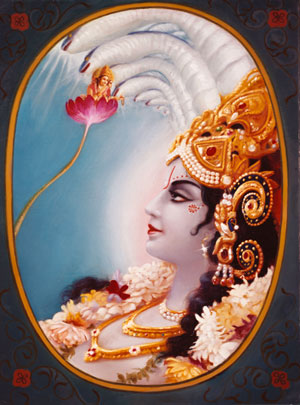 Since
according to Vedic tradition Lord Vishnu reclining on the coils of the
eternal cobra created the cosmos, it is but natural that statues
depicting Lord Vishnu as the creator and sustainer of the universe
should have been erected at important locations throughout the world
just as every household likes to nostalgically preserve and consecrate
a picture of its remotest known ancestor. Conversely, the existence of
Lord Vishnu's statues at a number of locations is strong evidence of
the universality of Vedic culture from the beginning of the world.
Since
according to Vedic tradition Lord Vishnu reclining on the coils of the
eternal cobra created the cosmos, it is but natural that statues
depicting Lord Vishnu as the creator and sustainer of the universe
should have been erected at important locations throughout the world
just as every household likes to nostalgically preserve and consecrate
a picture of its remotest known ancestor. Conversely, the existence of
Lord Vishnu's statues at a number of locations is strong evidence of
the universality of Vedic culture from the beginning of the world.
For those who find it difficult to believe in such a ready-made
creation, we would like to quote the words of a renowned scholar and an
ex-Assistant Director General of Archaeology under the British
administration in India, Mr. B.C. Chhabra. He writes,
"I do not want to go deep into the larger question of the theory of evolution, which is today at the base of archaeological interpretations, but I must need say that the history of Indian civilization begins with knowledge and not with barbarism. The kind of knowledge which has been preserved therein has stood the test of time and is still unsurpassed in certain respects. It believes in an evolution of limited extent only and that for a definite period of time in the history of man's life, as also in that of a nation. To base the entire history of mankind, down to the present day, on the ape-man and the archaeological age of Paleolithic, Neolithic, Bronze and Iron is a travesty of facts. Even in the present age of great scientific achievements the ape-man cannot produce the homosapiens, obviously because they are two different species. Recent archaeological excavations by Soviet archaeologists have proved abundantly that these ages have no meaning because different cultural ages are found in different regions and that sometimes they co-existed in the same region, which cannot be explained on the basis of the theory of evolution. Most of the objects discovered in these excavations belong to periods of less than 2000 B.C. Then what about the great civilizations of Crete, Egypt and Sumeria, whose findings are still a wonder of the world? Indians believe in the cycle theory (Meghdut 2/46): birth, rise, climax, decline and death, which is nature's law."
Those are wise words. They rightly question the very basic assumptions of modern archaeologists and imply that the Vedic concept of creation as a going concern is more cogent. The entire ancient world believed it to be so, and therefore statues of the reclining Vishnu used to be erected all over.
The Vishnu Statue in Delhi
In
India itself a gigantic statue of the reclining Vishnu lay under the
so-called Qutub Tower in Delhi, amidst a lake. The statue was so huge
that the Tower appeared to be a slender lotus stem rising from Vishnu's
navel. The tower was seven-storied to symbolize the concept of the 7th
heaven. At its top was a dome. Seated under the dome on a lotus seat
was the four-faced Brahma, holding the Vedas. Brahma was shown as
presiding over and supervising the creation from his heavenly perch.
Around the tower on the ground was the zodiacal ecliptic delineated by
temples symbolizing the 27 constellations. The stately gateway leading
to that Nakshatralaya (i.e. Constellation Enclave) known as Alai
Gateway still stands there. The Vishnu statue was erected in Delhi
(meaning "threshold" in Sanskrit), because Indraprastha, the capital of
Mahabharat times, was the hub of the Vedic world.
Below, from left: Qutub Tower and
surrounding ruins; Remnants of Vedic pillars remaining in the Qutub
complex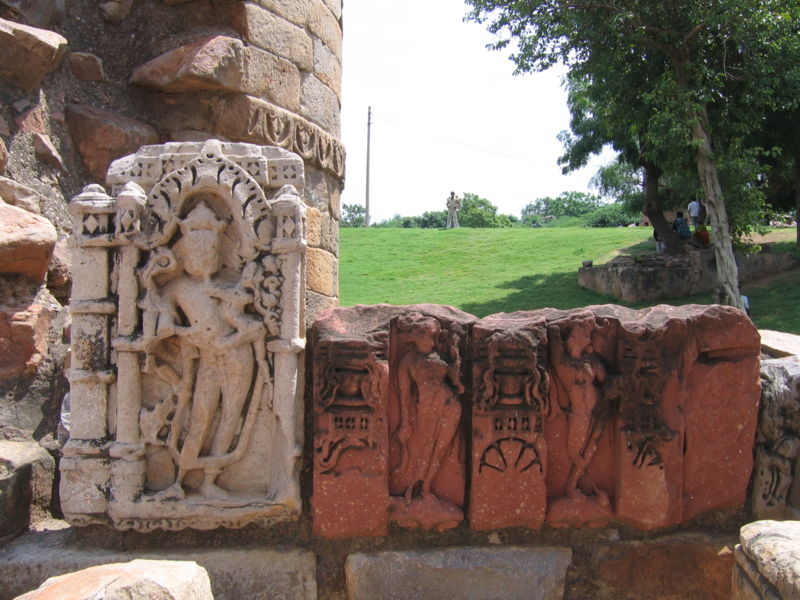 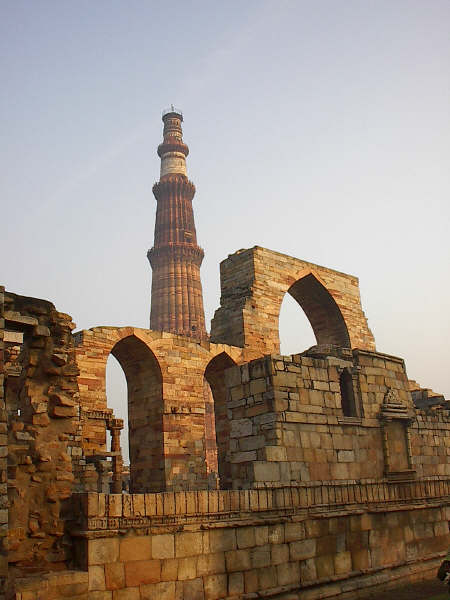 |
The Vishnu Statue in Britain
In
the opening part of the introduction to the volume titled A
Complete
History of the Druids [1], it is stated, "It
will be necessary to give an
explanation of the pillars, the Circle and Serpent."
On page 9 of the same book it is observed, "This Serpent was the symbol
of light and wisdom. Its name Seraph, particularly is so expressive."
The term Seraph is a malpronunciation of the Sanskrit term Serp (i.e.
Serpent), which indicates that the ancientmost language of the British
Isles, as also of other parts of the world, was Sanskrit.
On page 15 of the same book, it is asserted, "It may rationally be
concluded from the various opinions of the best historians that thi
island received its first inhabitants form the eastern parts of the
world."
Since people from the East (i.e. India) were the earliest inhabitants
of Britain, they naturally erected a statue of Lord Vishnu, the
progenitor of the world.
The name "Isle of Angelsey" in Britain derives from the Sanskrit name
of Lord Vishnu as Angulesh, i.e. the Lord of the Angul country. The
British Isles were designated Angulsthan, i.e. a finger-size,
finger-length country. If the European continent is likened to a palm,
then the British Isles appear to be an extended finger. Therefore,
Sanskrit-speaking explorers named it Angulsthan. It is that same term
which later came to be pronounced as Angul and i.e. England.
The book on Druids mentioned above states on page 36 that "Many temples
of the Druids are said to be yet in part remaining in this island (i.e.
the Isle of Man) and that of Angelsey ... many of them were made of
extraordinary large stones as at Abiry and Stonehenge."
Page 54 describes,
"Abiry [now known as Avebury] is founded on the more elevated part of a plain ... the entire figure of it (the ruins) is a Seraph or winged serpent transmitted through a circle. ... The outer part of the grand circle is a vast and lofty Vallum, with a very deep ditch on the inside of it near 80 ft or 45 cubits broad. Its diameter 750 cubits, its circumference 225 cubits, the enclosed area about 22 acres. Within the ditch was formed a circle of 100 enormous stones set upright, which were generally 15, 16 or 17 ft high, and near as much in breadth. ... Out of these 100 stones, 44 were still visible when Dr. Stukeley was there in the year 1722, whereof 17 were standing and 27 thrown down or reclining. Ten of remaining had been demolished by Tom Robinson in the year 1700, the vestigia of the rest were still discernible. With this mighty colonnade of 100 such stones in perfection, there must have been a most agreeable walk between them and the ditch. It is scarcely possible for us to form a notion of the grand and beautiful appearance it must then have made."
(On pages 56 to 59 is added:)
"Most of the houses, walls and outhouses of this town are built with the materials of these stones that have been fired and broken. ... Let us walk out now by the southern entrance of the town, passing the Vallum. This is Via Sacra ... the summit of the Overtone Hills is the hak-pen (a compound oriental word signifying the Serpent's head), which is 4000 cubits from the Vallum of Abiry. The people have a high notion of it and still call it the Sanctuary... which when in perfection was without question the most glorious temple of the kind which the world has ever heard of. That it was really a temple sacred to the ever-blessed and undivided Trinity, every circumstance, every consideration tends to persuade us... The name itself of Abiry (ABIRY, Potentates), signifying in the language of its founders "The Mighty Ones".
Below, from left: entrance to West Kennett
Long Barrow, Avebury;
aerial view of The Sanctuary, Avebury; Stone Circle,
Avebury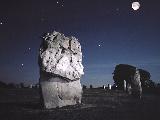 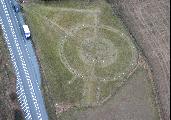 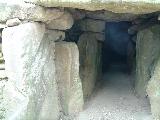 |
The
ditch mentioned above was for the lake, since Lord Vishnu is always
depicted as reclining on the coils of a cobra amidst a lake. The
opening sentences of the chapter of Genesis of the Old Testament of the
Bible actually refer to the scene, when it says that at the time of
creation, the spirit of God was floating on water.
The temple was a gigantic and glorious sanctuary of world fame, and the
Vedic trinity of the three Mighty Ones, via Brahma the creator, Vishnu
the sustainer and Shiva the destroyer were all there in the form of
gigantic statues. The Druids supervised the temple. The above
description makes it clear that the Isle of Angelsey was famous in the
ancient world for its majestic an massive temple depicting the Vedic
Trinity in gigantic stone-statuary as the divine governors of the world.
Reclining Vishnu in the Kaba
The
Kaba in Mecca is a huge temple complex built in the hoary past to a
Vedic Tantric design with the pattern of a square set askew over
another square to form the ubiquitous Vedic octagonal design.
An ancient Sanskrit scripture known as Harihareshwar Mahatmya has the
following couplet:

which
mentions Lord Vishnu's holy footprint consecrated at three main centres
in the world, namely one in Gaya (in India), the other in Mecca, and
the
third near Shukla Teertha, i.e. Abiry.
This information, when coupled with the information from Muslim sources
that there were 360 idols in the temple, indicates that Lord Vishnu was
surrounded by an entourage of other deities, of which Lord Shiva was
one. But the Muslims being iconoclasts, they destroyed the idols of
other deities, while Shiva's emblem, a round, cylindrical, dark,
black-red stone, they retained as a central, featureless object of
reverence.
The Muslim Palestinian name Yasser Arafat is in fact Sri Haripad, i.e.
the Holy feet of Lord (God) Hari. This name and others commemorate the
idol of Vishnu that was enshrined in the centre of the octagonal Kaba
shrine.
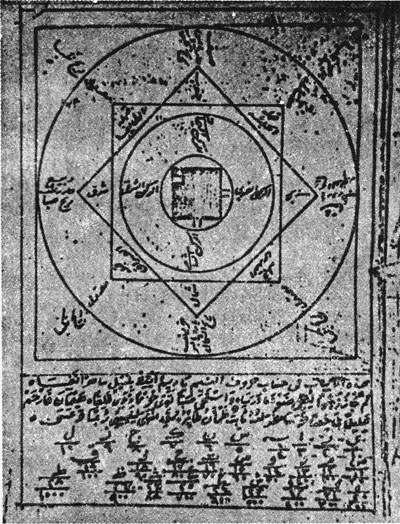
Ground plan of the Kaba at Mecca
(click on image to magnify)
Above
is the ground-plan of the hoary Kaba (Vishnu) temple constructed on the
esoteric, Tantric, octagonal Vedic pattern in Mecca, Saudi Arabia.
The
eight corners occupied the images of the sentinel Vedic deities Indra,
Varun, Yama, Agni, Vayu, Juber, Ishan and Nirut.
The
central square represents the present truncated Kaba, the central
sanctum housing the image of the Reclining Vishnu "in labour".
Therefore this shrine is remembered even in convert, Islamic tradition
as the Navel of the World.
Its
other name "Haram" is the Sanskrit term "Hariyam", i.e. the shrine of
Lord Vishnu alias Hari.
Note
the rectangular dent near the upper left corner of the central square.
That marks the spot where the cylindrical Shivling stone is vertically
partially embedded on the exterior of the southeast corner of the Kaba
wall. Therefore perambulation of the Shivling involves circling the
entire Kaba building. Even after conversion, Muslims feel compelled to
observe the seven-fold ancient Vedic perambulation. The Kaba sanctum
itself is always kept secretively shut to hide its Vedic interior.
The
seven-stories-high Kaba building is covered perpetually by a ghilaf,
i.e. a black burqa, hiding its Vedic saffron-colour stone surface,
lotus designs and what are believed to be Sanskrit inscriptions on the
inner side of the sanctum walls. International pressure on the Saudi
government should continue to be exerted by all countries until the
Kaba is thrown open to all people as in pre-Muslim times.
Reclining Vishnu in Rome
The
name Vishnu is pronounced as Vistu even in India, and so it used to be
pronounced in Europe. Therefore Vestal Virgins in Rome were girls
dedicated to Lord Vishnu.
The entire terminology associated with ancient historic Rome will be
found to be Vedic, Sanskrit. The Ventine hill unde the monastery of St.
Saba derives its name from Avanti, a famous ancient city in India. The
monstery of Saba is an ancient Shiva temple. The Paletine Hill in Rome
is the counterpart of Palitana, a city in the Saurashtra region of
India noted for its hill covered with numerous temples.
At Rome, the vault of the old well-house of the capitol is called the
Tullianum. Such well-houses are a common feature of ancient Hindu
temples and palaces. They may still be seen in Lucknow, in the Tejo
Mahalaya (alias Taj Mahal) temple palace in Agra, and in Ashoka's
palace (wrongly called Ferozshah Kotla) in Delhi and in several other
princely capitols. Such well-houses are known as Baoli-Mahals in Hindu
parlance.
"The gates of Roma Quadrata on the Palatine were not bare openings in
the line of wall but consisted of a square chamber with two dors, one
opening inwards an the other outwards. The temple of Janus was a
modification of such a gateway chamber."
That description is taken from page XXIV of the Introduction to the
volume titled Rome and the Campagna by R. Burn (Deighton,
Bell &
Co., London, 1871).
Those square gateways are a Hindu feature. They may be seen in almost
every historic mansion in India. In fact, we would like to suggest a
slight amendment. It may probably have escaped the notice of the
above-mentioned author Robert Burn (Fellow and Tutor at Trinity
College, Cambridge, U.K.) that the gateways have a subtle octagonal
feature about them. In the interior, every corner usually has some kind
of a joint, which gives it the appearance of a twin, turning the square
into an octagon.
Ganesh
Ganesh
receives homage at the entrance before one enters the sanctum to
worship the main deity.
The western side of the Tiber Valley in Rome is bounded by Vatican hill
and the long ridge of the Janiculum.
The Vatican is the Sanskrit name Vatica, i.e. Vedic hermitage. The term
Janiculum is the Sanskrit term Ganesalayam, i.e. a temple of Lord
Ganesh.
The Capitoline Hill and the Janiculum Hill are opposite to each other.
In between them flows the Tiber. On both those hills were temples of
Vedic deities. On the Capitoline was the temple of Saturn, and on the
Janiculum was that of Ganesh.
Thus, as in the Kaba (Mecca), in Rome too, Lord Vishnu was surrounded
by a number of other deities.
"...Historians and poets of Imperial Rome give us a description of the solemn ceremony observed on the occasion of marking out the limits of a new settlement.... a bull and a cow were yoked together, the cow being placed on the inner side, a furrow was made with a plough round the proposed site. This was done on a lucky day to satisfy religious scruples...." [2]
This
procedure of choosing an auspicious day with reference to
astrology and braeking the ground for a new city with a plough drawn by
kine is Vedic practice. As late as the early 17th century, Shivaji, a
Maratha ruler of India, adopted the same procedure when he first
arrived in Pune city to look after his fief. He had the land furrowed
with a gold-tipped plough.
The Arch of Constantine in Rome is a triple archway with a tall arch in
the centre, flanked by two smaller arches. This also is a common sight
in India.
"The temple of Hercules Victor was pulled down under Sixtus IV. The
statue of Hercules in bronze now in the capitol was found there,"
records R. Burn.
Hercules is the Sanskrit term Heri-cul-eesh, meaning the Lord of the
clan of Hari, i.e. Vishnu alias Krishna. The term Hercules Victor is
the Sanskrit term Hari-Vijay.
Forum Romanum is the ancientmost part of Rome. Romanum is Ramayanam,
obviously because that was the central point around which the city of
Rama was erected.
"The longer side of this piazza measured about 200 yards. ... Round this confined space were grouped the most important buildings of Republican Rome, the temples of the most ancient and venerated gods, the senate hose, the Comitium and the Rostra. ... The House of the Pontifex Maximus was a little further along the sacred way (Summae Sacra Via) and was called the Regia, the Atrium Regium or the Atrium Vestae. This Regia was the house of the Pontifex... The sacred spears of the God Mars were kept there...." [3]
The
above is a very important passage. It pinpoints the sacred Vedic
core of the ancient city of Rome. The city itself was named after Rama,
an incarnation of Vishnu, alias Vishtu. Therefore the highway leading
from it to the temple was known as the Regia, i.e. "royal way" i.e.
Raja Marg in Sanskrit. It was also known as Vestae from Vishnu and
Atrium from sage Atri. Ancient Italy was known as Etruria and its
civilization was known as Etruscan civilization, and the sea to its
east is known as the Adriatic Sea—all from the Vedic sage Atri, who had
his Vedic establishment in Rome in remote antiquity. The office of the
Pontifex Maximus, that is the chief priest of the Vishnu temple complex
in Rome, originates from sage Atri. The Sanskrit term Pantah Mahan has
been corrupted to Pontifex Maximus in Latin. His house was naturally a
part of this great temple complex, presided over by Lord Vishnu. And as
at the Kaba in Mecca, in Rome too Vishnu was surrounded by the other
deities such as His incarnations Rama and Krishna and planetary deities
such as Saturn and Mars.
The Italian word "Via" for highway is a truncated form of the Sanskrit
term Veethi.
The chief priest (the Pontifex Maximus) was from the time of
Constantine forced to call himself a Christian priest. Maximus is the
Sanskrit term Mahattamas, i.e. "the topmost".
1. — p.1, Preface to A Complete History of
the
Druids, Their Origins, Manners, Customs, Powers, Temples, Rites and
Superstitions, with an Inquiry into Their Religion and Its Coincidence
with the Patriarch by Lichfield, printer T.G. Lomax, marketed by
Longman, Hurst, Rees and Orms, London
Back to text
2. — p.31, Rome and the Campagna
by R. Burn Back to text
3. — p.41 ibid. Back to text
Reclining Vishnu Statues/ WORLD SANKIRTAN PARTY © 2004 - Hansadutta dasa
Home | About | Events | World Sankirtan Party | Inside Nam Hatta
KRSNA WORLD blog | eBooks | View Site Map | Store

Cities and Regions Since
The Unified Field Theory of History
The 5000-Year Barrier
The Vedas
Religious Scriptures
The historical perspective...
The Evolution of Spiritual Science
History - Human Civilization
Religion
Vedas - Vedic Authority
Back to Top
Back to Top
Back to Top
Back to Top
Back to Top
Back to Top
Back to Top
Back to Top
Back to Top
